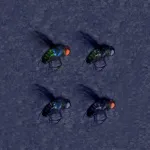INFORMATION:
First authors of the study include former UB students Nanditha Anandakrishnan, PhD, now a postdoctoral researcher at Icahn School of Medicine at Mount Sinai, and Hang Ye, PhD, now a research scientist at SprintRay Inc. Zipeng Guo, a current PhD candidate in Zhou's lab, also is a first author.
Additional co-authors at UB are from the Department of Biomedical Engineering, which is a joint program of the School of Engineering and Applied Sciences and the Jacobs School of Medicine and Biomedical Sciences; the Department of Industrial and Systems Engineering; the Department of Chemical and Biological Engineering; and the Department of Medicine in the Jacobs School.
Other study co-authors are from the VA Western New York Healthcare System; the Department of Cell Stress Biology at Roswell Park Comprehensive Cancer Center; and the Department of Biomedical and Chemical Engineering at Syracuse University.
The work was supported with funding from the National Institute of Biomedical Imaging and Bioengineering of the National Institutes of Health. The UB School of Engineering and Applied Sciences and the Jacobs School of Medicine and Biomedical Sciences provided additional funding.
Rapid 3D printing method moves toward 3D-printed organs
University at Buffalo-led research team advances technique that speeds up conventional 3D printing by 10-50 times
2021-03-05
(Press-News.org) BUFFALO, N.Y. -- It looks like science fiction: A machine dips into a shallow vat of translucent yellow goo and pulls out what becomes a life-sized hand.
But the seven-second video, which is sped-up from 19 minutes, is real.
The hand, which would take six hours to create using conventional 3D printing methods, demonstrates what University at Buffalo engineers say is progress toward 3D-printed human tissue and organs -- biotechnology that could eventually save countless lives lost due to the shortage of donor organs.
"The technology we've developed is 10-50 times faster than the industry standard, and it works with large sample sizes that have been very difficult to achieve previously," says the study's co-lead author Ruogang Zhao, PhD, associate professor of biomedical engineering.
The work is described in a study published Feb. 15 in the journal Advanced Healthcare Materials.
It centers on a 3D printing method called stereolithography and jelly-like materials known as hydrogels, which are used to create, among things, diapers, contact lenses and scaffolds in tissue engineering.
The latter application is particularly useful in 3D printing, and it's something the research team spent a major part of its effort optimizing to achieve its incredibly fast and accurate 3D printing technique.
"Our method allows for the rapid printing of centimeter-sized hydrogel models. It signi?cantly reduces part deformation and cellular injuries caused by the prolonged exposure to the environmental stresses you commonly see in conventional 3D printing methods," says the study's other co-lead author, Chi Zhou, PhD, associate professor of industrial and systems engineering.
Researchers say the method is particularly suitable for printing cells with embedded blood vessel networks, a nascent technology expected to be a central part of the production of 3D-printed human tissue and organs.
ELSE PRESS RELEASES FROM THIS DATE:
Online dating: Super effective, or just... superficial?
2021-03-05
According to the Pew Research Center, 1 in 10 American adults have landed a long-term relationship from an online dating app, such as Tinder, OKCupid and Match.com. But what compels people to "swipe right" on certain profiles and reject others?
New research from William Chopik, an associate professor in the Michigan State University Department of Psychology, and Dr. David Johnson from the University of Maryland, finds that people's reason for swiping right is based primarily on attractiveness and the race of a potential partner, and that decisions are often made in less than a second.
"Despite online dating becoming an increasingly popular way for people to meet one another, ...
New 'split-drive' system puts scientists in the (gene) driver seat
2021-03-05
Powerful new genetic engineering methods have given scientists the potential to revolutionize several sectors of global urgency.
So-called gene drives, which leverage CRISPR technology to influence genetic inheritance, carry the promise of rapidly spreading specific genetic traits throughout populations of a given species. Gene-drive technologies applied in insects, for example, are being designed to halt the spread of devastating diseases such as malaria and dengue by preventing mosquito hosts from becoming infected. In agricultural fields, gene-drives are being developed to help control or eliminate economically ...
Survey identifies factors in reducing clinical research coordinator turnover
2021-03-05
Strong, collaborative relationships with principal investigators are a key factor of longevity in clinical research coordinator positions -- an essential, but increasingly transient job in executing treatment-advancing clinical trials, Vanderbilt University Medical Center researchers found.
Danielle Buchanan, BS, clinical translational research coordinator III in the Department of Neurology, and Daniel Claassen, MD, MS, chief of the Division of Cognitive Disorders and associate professor of Neurology, found the top factor for retention is a close working relationship between clinical research coordinators (CRCs) and the study's principal investigator that emphasizes respect and collaboration. Salary followed as the next factor for retention among 85 former or current CRCs who responded to ...
Study reveals how egg cells get so big
2021-03-05
Egg cells are by far the largest cells produced by most organisms. In humans, they are several times larger than a typical body cell and about 10,000 times larger than sperm cells.
There's a reason why egg cells, or oocytes, are so big: They need to accumulate enough nutrients to support a growing embryo after fertilization, plus mitochondria to power all of that growth. However, biologists don't yet understand the full picture of how egg cells become so large.
A new study in fruit flies, by a team of MIT biologists and mathematicians, reveals that the process through which the oocyte ...
Vision impairment is associated with mortality
2021-03-05
The global population is aging, and so are their eyes. In fact, the number of people with vision impairment and blindness is expected to more than double over the next 30 years. ...
WRAIR, Duke scientists identify of monoclonal antibodies efficacy against malaria
2021-03-05
Scientists at Walter Reed Army Institute of Research, in a collaboration the Duke University, have confirmed that monoclonal antibodies can be an effective tool in the global fight against malaria.
The study, led by Dr. Sheetij Dutta, chief of the Structural Vaccinology Laboratory at WRAIR, showed that mAbs such as CIS43 were most effective in a culture-based assay that measured a malaria parasite's ability to infect a human liver cell, while another mAb 317 showed the best activity in a mouse infection model. Dutta added, "difference in assay outcomes for mAbs could reflect distinct sites on the circumsporozoite protein, that can be exploited for developing improved vaccines." The study results were published today in in Nature Scientific Reports.
Despite decades ...
Three-layered masks most effective against large respiratory droplets
2021-03-05
If you are going to buy a face mask to protect yourself and others from COVID-19, make sure it's a three-layered mask. You might have already heard this recommendation, but researchers have now found an additional reason why three-layered masks are safer than single or double-layered alternatives.
While this advice was originally based on studies that showed three layers prevented small particles from passing through the mask pores, researchers have now shown that three-layered surgical masks are also most effective at stopping large droplets from a cough or sneeze from getting atomized into smaller droplets. These large cough droplets can penetrate through the single- and double-layer masks and atomize to much smaller droplets, ...
New molecular driver of frontal circuit maturation discovered
2021-03-05
Mount Sinai Researchers find a new way to prevent attention deficits associated with Fragile X, a leading genetic cause of autism, in an animal model
Corresponding Author: Hirofumi Morishita, MD, PhD, Department of Psychiatry, Neuroscience, Friedman Brain Institute, Mindich Child Health and Development Institute, Icahn School of Medicine at Mount Sinai, New York.
Bottom Line: The adolescent maturation of the frontal cortex is important for establishing cognitive function, and disruption of this process is associated with neurodevelopmental disorders. This study uncovered a new molecular driver of frontal circuit maturation that is essential ...
Coastal changes worsen nuisance flooding on many U.S. shorelines, study finds
2021-03-05
ORLANDO, March 5, 2021 - Nuisance flooding has increased on U.S. coasts in recent decades due to sea level rise, and new research co-authored by the University of Central Florida uncovered an additional reason for its added frequency.
In a study appearing today in the journal Science Advances, researchers show that higher local tide ranges, most likely from human alterations to coastal areas and estuaries, has increased the number of nuisance flooding days in many coastal locations in the U.S.
Coastal nuisance flooding is considered to be minor flooding from the seas that causes problems such as flooded roads and ...
Study shows cactus pear as drought-tolerant crop for sustainable fuel and food
2021-03-05
Could cactus pear become a major crop like soybeans and corn in the near future, and help provide a biofuel source, as well as a sustainable food and forage crop? According to a recently published study, researchers from the University of Nevada, Reno believe the plant, with its high heat tolerance and low water use, may be able to provide fuel and food in places that previously haven't been able to grow much in the way of sustainable crops.
Global climate change models predict that long-term drought events will increase in duration and intensity, resulting in both higher temperatures and lower levels of available water. Many crops, such as rice, corn and soybeans, have an upper temperature limit, and ...
LAST 30 PRESS RELEASES:
Mapping ‘dark’ regions of the genome illuminates how cells respond to their environment
ECOG-ACRIN and Caris Life Sciences unveil first findings from a multi-year collaboration to advance AI-powered multimodal tools for breast cancer recurrence risk stratification
Satellite data helps UNM researchers map massive rupture of 2025 Myanmar earthquake
Twisting Spins: Florida State University researchers explore chemical boundaries to create new magnetic material
Mayo Clinic researchers find new hope for toughest myeloma through off-the-shelf immunotherapy
Cell-free DNA Could Detect Adverse Events from Immunotherapy
American College of Cardiology announces Fuster Prevention Forum
AAN issues new guideline for the management of functional seizures
Could GLP-1 drugs affect risk of epilepsy for people with diabetes?
New circoviruses discovered in pilot whales and orcas from the North Atlantic
Study finds increase in risk of binge drinking among 12th graders who use 2 or more cannabis products
New paper-based technology could transform cancer drug testing
Opioids: clarifying the concept of safe supply to save lives
New species of tiny pumpkin toadlet discovered in Brazil highlights need for conservation in the mountain forests of Serra do Quiriri
Reciprocity matters--people were more supportive of climate policies in their country if they believed other countries were making significant efforts themselves
Stanford Medicine study shows why mRNA-based COVID-19 vaccines can cause myocarditis
Biobanking opens new windows into human evolution
Sky-high smoke
AI tips off scientists to new drug target to fight, treat mpox
USC researchers develop next-generation CAR T cells that show stronger, safer response in animal models
New study reveals Industrial Revolution’s uneven health impacts across England
Vine-inspired robotic gripper gently lifts heavy and fragile objects
Fingerprint of ancient seafarer found on Scandinavia’s oldest plank boat
Lunar soil analyses reveal how space weathering shapes the Moon’s ultraviolet reflectance
Einstein’s theory comes wrapped up with a bow: astronomers spot star “wobbling” around black hole
Danforth Plant Science Center to lead multi-disciplinary research to enhance stress resilience in bioenergy sorghum
Home-delivered groceries improve blood sugar control for people with diabetes facing food insecurity
MIT researchers identified three cognitive skills we use to infer what someone really means
The Iberian Peninsula is rotating clockwise according to new geodynamic data
SwRI, Trinity University to study stable bacterial proteins in search of medical advances
[Press-News.org] Rapid 3D printing method moves toward 3D-printed organsUniversity at Buffalo-led research team advances technique that speeds up conventional 3D printing by 10-50 times






